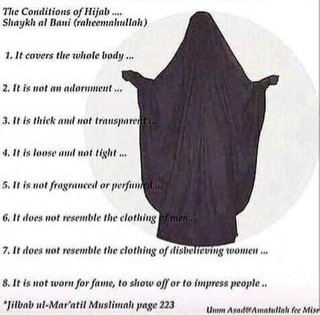
The hijab is compulsory upon the Muslim woman as soon as she reaches the age of puberty. The intention should be for the sake of Allah alone and not because of culture or because everyone is wearing it in my community. That’s only when a person would be rewarded.
As Allah commanded in the Quran:
“O Prophet, tell your wives and your daughters and the women of the believers to bring down over themselves [part] of their outer garments. That is more suitable that they will be known and not be abused. And ever is Allah Forgiving and Merciful”.
Suratul Ahzab verse 59.
The hijab is not a scarf worn over tight clothing. It has some criteria that must be observed for it to fall under the hijab.
Sheikh Albani gave some criteria to be followed in his book “Jilbaab al-Mar’atil-Muslimah fil-Kitaab was-Sunnah”
These are the criteria for a hijab:
1) Extent: This is for men and for women alike. The extent of covering obligatory on the male is to cover the body at least from the navel to the knee. For women, it’s obligatory to cover completely except the face and hands up to the wrist.
If they wish to, they can cover these parts too. Some scholars of Islam insist that the face and hands are parts of the obligatory extent of the hijab.
All the remaining criteria are the same for men and women.
2) The clothes should be loose and not reveal the figure.
Usaamah ibn Zayd said: “The Messenger of Allaah (peace and blessings of Allaah be upon him) gave me a thick Egyptian garment that was one of the gifts given to him by Duhyat al-Kalbi, and I gave it to my wife to wear. He said, Why do I not see you wearing that Egyptian garment? I said, I gave it to my wife to wear. He said, Tell her to wear a gown underneath it, for I am afraid that it may describe the size of her bones.”
(Narrated by al-Diyaa al-Maqdisi in al-Ahaadeeth al-Mukhtaarah, 1/442, and by Ahmad and al-Bayhaqi, with a hasan isnaad).
3) The clothes should not be transparent such that one sees through.
The Prophet (peace and blessings of Allaah be upon him) said: During the last days of my ummah there will be women who are clothed but naked, with something on their heads like the humps of camels. Curse them, for they are cursed. Another hadeeth adds: They will not enter Paradise or even smell its fragrance, although its fragrance can be detected from such and such a distance.
(Narrated by Muslim from the report of Abu Hurayrah).
4) The clothes should not be and perfumed.
Abu Moosa al-Ashari said: the Messenger of Allaah (peace and blessings of Allaah be upon him) said: Any woman who puts on perfume then passes by people so that they can smell her fragrance, is an adulteress.
Narrated by Abu Dawood (4173) and al-Tirmidhi (2786).
5) The clothes shouldn’t resemble that of the opposite sex.
Abu Hurayrah said: The Messenger of Allaah (peace and blessings of Allaah be upon him) cursed the man who wears women’s clothes, and the woman who wears men’s clothes.
Narrated by Abu Dawood (4098)
6) The clothes should not resemble that of the unbelievers.
The Prophet (peace and blessings of Allaah be upon him) said: “Whoever imitates a people is one of them.” Narrated by Abu Dawood, 4031.
7) The dress should not be adorned.
The hijab is to protect and conceal the Muslim woman but not to beautify her. It’s not for beautification. As Allah said,
“And tell the believing women to lower their gaze (from looking at forbidden things), and protect their private parts (from illegal sexual acts) and not to show off their adornment except only that which is apparent (like both eyes for the necessity to see the way, or outer palms of hands or one eye or dress like veil, gloves, headcover, apron), and to draw their veils all over Juyoobihinna (i.e. their bodies, faces, necks, and bosoms) and not to reveal their adornment except to their husbands, or their fathers, or their husband’s fathers, or their sons, or their husband’s sons, or their brothers or their brother’s sons, or their sister’s sons, or their (Muslim) women (i.e. their sisters in Islâm), or the (female) slaves whom their right hands possess, or old male servants who lack vigour, or small children who have no sense of feminine sex. And let them not stamp their feet so as to reveal what they hide of their adornment. And all of you beg Allaah to forgive you all, O believers, that you may be successful”
[al-Noor 24:31]Complete Hijaab besides the criteria of clothing also includes the moral conduct, behavior, attitude, and intentions of the individual. A person only fulfilling the criteria of the Hijaab of clothes is observing Hijaab in a limited sense.
Hijaab of the clothes should be accompanied by the Hijaab of the eyes, heart, thoughts, and of intention. It also includes the way a person walks, talks, and behaves.
By Shukrah Ibrahim




